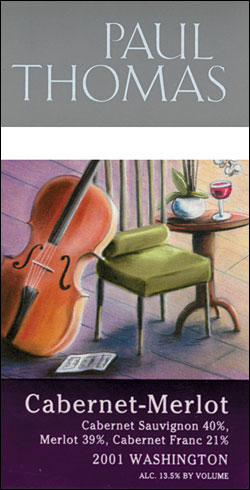Last Wednesday Richard Kinssies devoted his weekly P-I column to “second-label” wines from some of Washington’s premium producers. Usually made from grapes from the state’s top vineyards that didn’t quite make the cut for inclusion in the vintners’ much pricier top-of-the-line wines, these bottlings averaging about $15 retail offer exceptionally good value. But $15 is still a lot to spend night after night for home dining. Is it “Three-Buck Chuck” or nothing? Fortunately, Washington state wine lovers have an intermediate alternative: Check out the line of bottlings Canandaigua Wine Company has just issued under its proprietary Paul Thomas label.
Paul Thomas wines have always been a good buy, but with the 2001 vintage, they’ve become competitive in both price and quality with the best inexpensive lines from California and abroad. One, a blend of cabernet sauvignon, merlot, and cabernet franc, just won a gold medal in San Diego, competing against wines costing five, six, even eight times as much. For $7, you’re not likely to get a better deal anywhere.
The 2001 Paul Thomas vintage was the first shepherded from vineyard to bottle by Kerry Norton, winemaker for Canandaigua’s midprice Covey Run line. Any careful vintner can make good wine from small-cropped premium fruit; it takes more craft to bring out the best in more moderately priced fruit, and Norton appears to have what it takes. Most surprising of his first four releases is his 2001 chardonnay. Norton drew on fruit from 13 vineyards, emphasizing cooler sites with longer growing seasons where fruit can ripen without losing too much acidity. The result is remarkably crisp for a Washington chardonnay. People who like their chards buttery and oily will have to look elsewherebut they can also plan to spend at least twice as much, and they still probably won’t get wine as food-friendly as this one.
All Norton’s Paul Thomas reds contain an admixture of cabernet franc, ranging from a bare whiff (2 percent in the ’01 merlot) to a major component in the prizewinning cab-merlot blend (a full 21 percent). Norton uses cab franc to soften the roughness of tannins in the cabs and merlots he uses. These wines are meant for immediate drinking and won’t have time to “soften” in bottle. Our favorite of the four is the straight cabernet sauvignon: a modest wine, but beautifully balanced, with just enough new oak to give it a little zing. If you don’t trust us, pick up a bottle to take to a neighbor’s barbecue. Chances are you’ll be back for a case.








